The evolution of sports card continues to evolve as so does the History of Baseball Cards as today they are known as great alternative investments to stocks. Since the earliest days, baseball cards have been a passion of sports card collectors around the United States while becoming more popular in the early 1960’s through modern day baseball collecting. Once a hobby that grew so big that sports cards stores were found in nearly every major city in the USA, now evolves around the use of technology including online websites as well as sites such as Amazon and eBay with huge followings on baseball cards reddit sites and Facebook baseball card groups.
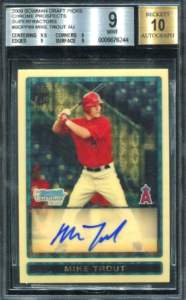
As we start to look at the history of baseball cards, the first thing many people think when they hear the words baseball card is a piece of cardboard. Depending on who you ask or talk to sports cards with, individuals from the mid 1950’s through early 1980’s may say I used to put them in my bike spokes while others said they collected baseball cards, but their parents threw them away. You will even get the occasional response that they used them to pitch against friends with the winner keeping the cards.
Before you know the card, industry was booming in the late 1980’s led by the introduction of Upper Deck Baseball cards that included the Ken Griffey JR Rookie Card. This created an insane buzz leading to baseball card collectors to spend time looking for sports card near me as well as traveling to baseball card shows around the United States. The boom would only last so long before a strong collapse and an eventual strong return that has seen sports cards including top rookie’s cards including the Mickey Mantle Rookie Card, Mike Trout Rookie Card as well as Honus Wagner cards to skyrocket in price.
As this quick history lesson got you all caught up with the History of Baseball Cards, read on to learn more about the overall History of Baseball Cards.
History of Baseball Cards
History of Baseball Cards – Baseball Card Timeline
Earliest Baseball Cards
When it comes to the earliest baseball cards, many debates have been made to when baseball cards started to be produced and what baseball cards are considered the first baseball cards. As this is debated, the earliest baseball cards date back to 1869 as Peck and Snyder introduced what many considered the first set of baseball cards featuring the Red Stocking Baseball Club of Cincinnati or the Cincinnati Red Stockings. Peck and Snyder trading cards measured two different sizes with one measuring 4 3/16 of an inch by 3 5/16 of an inch, as well as smaller version that measured 3 15/16 of an inch by 2 3/8 of an inch.
Tobacco Baseball Cards
After the Peck and Snyder baseball cards, the next wave of baseball cards would be released by Goodwin & Company that also owned multiple tobacco companies. These baseball cards are often referred to as tobacco cards and are highly collectible sports cards in today’s market that were packaged as a gimmick to cigarette smokers found inside the packs. Others tobacco companies followed along including the American Tobacco Company (ATC) who would introduce one of the most sought out sports cards all-time and one of the most expensive baseball cards ever. That card is the T206 Honus Wagner card that was included in cigarette packs despite Honus Wagner indicating he did not want his card in the product to prevent children from smoking.
Product Giveaway Baseball Cards
In 1914, after figuring out the popularity with baseball cards being inserted within cigarette packs, Crack Jacks which were known for the small toys, elected to start including baseball cards within their boxes of caramel coated popcorn and peanuts product. These Cracker Jack baseball cards that were available in 1914 and 1915 are highly sought after much like many of the earliest baseball cards. The 1914 Cracker Jack Baseball Set Checklist featured 144 total cards while the 1915 Cracker Jack Baseball Set Checklist featured 176 cards.
Mass Production Baseball Cards
Finally, nearly 18 years, later the first mass production baseball card set hit the market as the Goudey Gum company introduced the first baseball card product sold to the market that featured a stick of bubble gum the 1933 Goudey Baseball Card. The set is loaded with Hall of Famers including greats such as Ted Williams, Lou Gehrig and Babe Ruth. Within the 240 card set, Babe Ruth was featured four different times. Over the next few years various gum companies and other companies would produce baseball cards including Play Ball Cards which was released by Gum Inc of Philadelphia which also features the 1939 Ted Williams Rookie Card.
Bowman Baseball & LEAF ERA Arrives
As the baseball card ERA continued to march on the introduction of the Bowman Baseball ERA arrived with the introduction of the 1948 Bowman Baseball set which was produced by Gum Inc. The initial 1948 Bowman Baseball Set Checklist consists of just 48 total cards including the Stan Musial Rookie Card. In addition to Bowman, LEAF introduced their first set of baseball the 1949 Leaf Baseball cards that feature Jackie Robinson and Satchel Paige Rookie Cards. Over the next few years Bowman would strike gold releasing sets of some of the greatest Baseball Players to play the game including the 1951 Mickey Mantle Rookie Card (1951 Bowman).
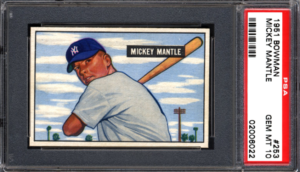
Topps Baseball Cards
The time had arrived for Topps Gum Company to break on the scene while becoming the face of the industry till modern sports card collecting of the 2000’s. Topps released their first product in 1951 the Topps Red Back product and followed that product up with the 1952 Topps Baseball Card Set that features another popular card of Mickey Mantle. Topps and Bowman would dominate the market for many years with Topps holding the rights to producing baseball cards till the early 1980’s.
A new time of Baseball Card Collecting
After once being dominated by the Topps Monopoly, the baseball card landscape began to change as both Fleer and Donruss won the rights to start producing baseball card sets and products. This was what many considered is the start of the Junk Card ERA or the Junk Wax ERA. While baseball cards grew in popularity, products would begin to be over produced and even printed years after the products would be released. As Donruss and Fleer were strong companies, new companies emerged with new designs, state of the art sports cards and holographic photos. These companies included companies like Upper Deck who changed the industry releasing the 1989 Upper Deck Baseball Card set that featured the Ken Griffey Jr Rookie Card. In addition, other companies such as Flair also put their stamp on the market. In addition Beckett Monthly and Tuff Sports grading guides, helped allow customers to see market prices of cards which led to an increase in card collecting and potential investment opportunities.
Baseball Card Grading & Sports Card Grading
As the Junk Wax ERA put a hurting on the baseball card landscape, sports card grading entered the industry at the start of 1991 as PSA entered the industry to officially start distributing individual grades to sports cards to help increase the value and rarity of the cards including graded baseball cards. As Professional Sports Authenticator (PSA) build a statue within the industry other companies such as Sportscard Guaranty (SGC) and Becket Grading Services (BGS) have also came along to joining the sports card grading industry while the three are considered the three best sports card grading companies within the industry.
Sports Card Stores, Baseball Card Stores Near Me & Baseball Card Shows
As the baseball card hobby was buzzing so was the local sports card stores and baseball card stores as they slowly emerged in every major city with some larger cities potentially have multiple shops. As sports collectors flocked to buy, sell and trade within the local baseball card stores, baseball card shows were appearing in newspaper ads all around the country. While the three led to the explosion of card collecting, the collapse of the industry shut many sports card stores doors and baseball card shows have slowly made a comeback.
Autographed & Memorabilia Cards
With base set that included Topps Baseball Sets, Fleer Baseball Sets and Donruss Baseball Sets seeing little to no value, the industry starting to collapse sports card companies looked for additional ways to appeal to sports card collectors, sports card trading shops and to help increase the buzz that once was present. With this need, sports card companies began to insert autographed cards such as the Mickey Mantle and Ken Griffey Jr dual autograph as well as cards featuring actual game used memorabilia of players jerseys, equipment, cleats and hats within products.
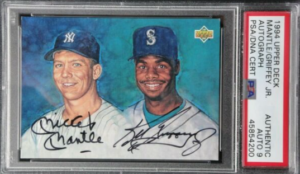
The first autographed inserts were released by Upper Deck that included Nolan Ryan and Reggie Jackson among the Upper Deck Baseball Heroes insert collection. Upper Deck continued the trend setting with the release of the first game used baseball cards with the release of the 1997 Upper Deck Game Jersey cards.
eBay and Check Out My Cards (COMC)
As digital technology slowly takes over our lives, the same has taken place with the baseball card collecting hobby as well. With the introduction of eBay, the history of baseball cards has evolved while allowing card collectors to buy, sell and trade baseball cards from their computer and now smart phones. This led to eBay one of the most impactful tools in the sports card industry and one of the main pricing component that baseball card collectors used to value their cards. Later on, new online sites such as Check Out My Cards (COMC) have emerged giving collectors additional online baseball card marketplaces to shop from.
Pandemic Impact on Baseball Cards and Prices
As baseball cards as well as other sports card products made a comeback through the 2000’s, the COVID-19 pandemic made a huge impact on the baseball card hobby as card values of new baseball card products exploded, the demand for baseball card grading and sports card grading exceeded the capabilities of the major sports card grading companies and the values of sports cards including baseball cards have skyrocketed. This includes seeing multiple cards reach sales above one million dollars a piece including the Mike Trout SuperFractor leading all MLB baseball card sale prices.
Other new trends in baseball card collecting
With the heavy demand for graded baseball cards, new companies have emerged to compete with the top sports grading companies including Certified Sports Guaranty (CSG) as well as Artificial Intelligence (AI) Sports card grading. In addition, Sports Card Breaking or Box Breaks have allowed collectors a new way to collect without the need to purchase full box products, but individual players or teams based on the break they join.
The baseball card collector would then pay another company for that team or player, that company would break open the product (box, case or multiple case), then all cards of that player or team would be shipped to the person who purchased that player or team. Other new trends in baseball card collecting includes Baseball card Hot Packs and Baseball Card Repacks. Learn more about Sports Card Repacks and Hot Packs.
What will the baseball card industry look like five years from now, 10 years from now or even 20 years from now? No one knows but for now the baseball card collecting hobby is as live as ever.
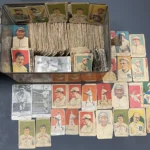

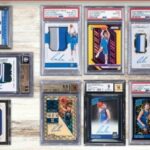

2 Comments